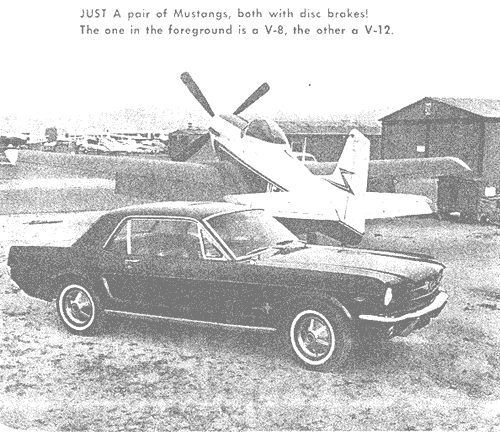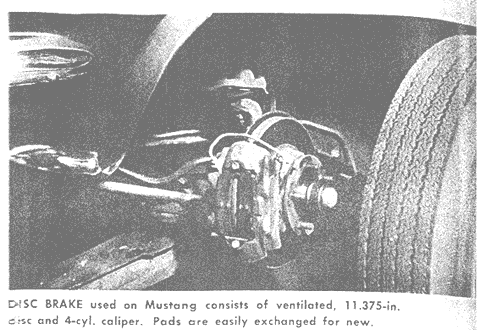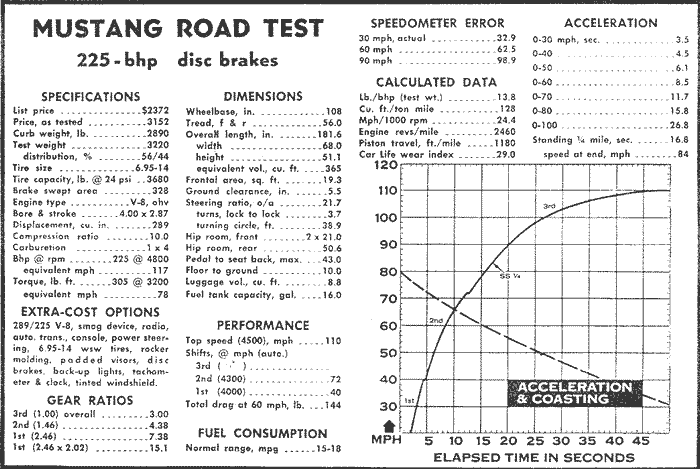 |
||||||
 |
||||||
 |
||||||
 Mustang
has everything going for it except exclusivity. It's impossible to drive more
than a few miles without spotting one or more. They've grown so commonplace
that Mustangs don't bother to wave at each other. Not that they could expect
recognition from those who remember the special art of waving, but some sort
of camaraderie might have been hoped for. Anyway, it didn't happen and now there's
discouragement in numbers.
Mustang
has everything going for it except exclusivity. It's impossible to drive more
than a few miles without spotting one or more. They've grown so commonplace
that Mustangs don't bother to wave at each other. Not that they could expect
recognition from those who remember the special art of waving, but some sort
of camaraderie might have been hoped for. Anyway, it didn't happen and now there's
discouragement in numbers.
That was all part of another era, a time when brave iconoclasts took to newly re-discovered sports cars from overseas in revolt against growing Detroit ostentation and ossification. Certainly it was a rare wave who was seated in a car which commanded an annual production rate approaching a single month's output of Mustangs. That was basic to the ritual, and dearness in price served as another criterion. But few, very few, were more unadulterated automobile than the range pony from the Rouge River Valley.
It has been more than one year since the first of the thundering herd pounded over the horizon. It was an epic scene:
News magazines reported the event in depth, corporate medicine men rhythmically beat the tom-toms, crowds of the curious and the enthusiastic inspected the all-too-rare specimen which could be held in some dealer's corral. There were scoffers and doubters aplenty; there still are. But there were also those who detected the bloodlines of the thoroughbred, the sinewy stock of the tough cactusland cayuse and the nimble balance of a polo pony all blending into a hybrid breed. Those who saw this apparently numbered thousands and so began some of the most spirited horse-trading ever seen inside this country's sales barns.
During that first year, Mustangs were purchased in such ever-increasing numbers that only three other brands could claim more action, if not reaction. This automobile in 12 months' time outdistanced at least a dozen other major domestic brands including, it should be noted, some other potent and racy machinery though it had handicapped itself by a few years in the sales race. Hardly a recognized measuring point passed that the Mustang didn't surpass some record in its breakneck overhaul of its competitors. At the end of its first nine months, it had surpassed the unthinkable 250,000 landmark in sales; before its first anniversary 400,000 had been sold and it was still running strong. popularity in itself some measure of the machine?
Of the three makes still ahead of Mustang in sales, could be considered more than a mere appliance devised pamper man's lethargy, strangle his rapidly dwindling road space, and satisfy his acquisitonal instincts for largesse. Mustang appeals to other appetites and may well carry a message for those cars it has passed as well as those which it still presses.
To discover (or more correctly, to rediscover) those traits which have helped Mustang gallop to its present pinnacle, we borrowed one of the most popular versions of the car powered by the 225-bhp V-8, driving through an automatic transmission, and was fitted with the optional front wheel disc brakes which had been so long awaited. The conservative dark green color was complemented with a two-tone green interior, and with a thin, white pin-stripe out- I lining the side panel indentation in place of the phony rear scoop, it was a picture of tastefulness.
 Here
was a car that wanted to run. With the relatively long 3.00:1 rear axle ratio,
it was in its element on long open ¦ stretches of highway. It could cruise
contentedly hour after hour without faltering, all the time exhibiting a healthy
respect for the price of gasoline. There are, of course, more economical Mustangs
but they are not quite so happy when great stretches of time and distance are
to be faced.
Here
was a car that wanted to run. With the relatively long 3.00:1 rear axle ratio,
it was in its element on long open ¦ stretches of highway. It could cruise
contentedly hour after hour without faltering, all the time exhibiting a healthy
respect for the price of gasoline. There are, of course, more economical Mustangs
but they are not quite so happy when great stretches of time and distance are
to be faced.
Yet, it also had a certain impatience when forced into run-ing short errands. Though not the sprinter some of its empowered and shorter-geared companions are, it none the less let the driver know it preferred to do and be done these menial chores with briskness and dispatch. Idling around town to gawk at the scenery was a situation which made this car decidedly unhappy.
With free-breathing 4-barrel carburetion, its engine almost craved exercise. The torque converter of its 3-speed Cruise-0-Matic transmission would whisk it away from the stop light and, if one wasn't paying full attention, have shifted into high and be charging away from the traffic pack before the driver awoke to the fact. Part of the reason this, to be sure, was its lack of fussiness The engine and transmission worked so well together around town that there is only the low hum of an underhood lullaby to intrude on the driver's reverie.
Adding to the pleasantness and, in some cases, exhilaration of the car was its nimbleness and responsiveness. While quite on par with some imported cars, it was of a quality to shame most other domestic autos. The Mustang's major vice was present, to be sure, in an occasional reluctance to keep its rear tires working during periods of exuberant cornering particularly on wet or rough pavement. But even this was well within bounds and easily corrected and controlled.
The 6.95-14 tires with which the test car was fitted keep its handling qualities on the plus side. But the tires also contributed to a sizeable speedometer error, just as they enhanced the aforementioned impression of easy distance driving. The-ultraconservative speedometer readings, in particular, meant that the braking tests were spectacular than bargained for, as later calculations revealed.
The brakes one of the primary reasons for testing the car were the optional 11.375-in. front wheel discs of ventilated cast iron with regular 10-in. rear drums. Usual testing procedure is to apply full pressure, just short of locking the wheels, twice in succession from 80 mph and recording the maximum deceleration rate. The disc/drum system performed quite well, registering a best-of-the-line 23 ft/sec./ sec. with no evidence of fade. The rear drums did show a tendency to bind from the effects of a lighter rear loading and the natural weight shift toward the front, but this was easily controlled by backing off the pedal slightly. Braking effectiveness, in fact, was almost directly proportional to the amount of pedal pressure, since the system did not include power assist. It was just as well that they did a better than average job of pinching off speed, however, because the road used for the test ended rather abruptly at a highway department barrier. Had the drivers known they were stopping from almost 10 mph faster, or had they been in a car with lesser brakes, the deceleration rates would have registered a sudden all-time high.
Fat-treaded tires are not to be discounted in their aid to braking as well as traction (which amount to the same thing), but the normal road test braking results corresponded well with earlier comparative tests which Car Life conducted among all five domestic makes which offer the disc systems. At that time, 10 consecutive stops were made from 80 mph and the Mustang averaged between 24 and 26 ft./sec./sec., with a one-time best stop of 29. However, the same tendency for the rear to lock was evident then, to a greater degree than was the case with Continental and Thunderbird. It would seem that the pressure limiting valves for the rear hydraulic lines on the latter two, designed to overcome this problem, did somewhat the better job. They cut in at 450 psi line pressure while the Mustang's goes to work at only 300.
Nonetheless, the Mustang's disc brake option (which costs $54 extra) overcomes one of the two major shortcomings which the car has had for the serious driver. The other-quicker and even more precise steering is still to come. But the car now is able to stop as well as go, which can be the more important consideration when things get tight.
And "tight" is a perfect description of the test car after the drivers rolled up many miles on it. Despite its lower-priced nature, this and most other Mustangs we have tried seemed solidly built. No creaking joints or groaning body panels materialized, which says volumes about the basic engineering involved in the platform frame. There was some drumming noise transmitted through the body from the road surface, as is true of all unitized cars, but it was hardly objectionable. The non-fussy nature of the engine conspired with the taut construction to make this example a real Quiet One.
During the past year, various owners have complained in some measure about the Mustang's seating and comfort, particularly on longer trips. Though our test drivers took special note of this, they could find only one area for complaint: The lack of rear seat armrests, in company with the "coved" rear seat back, left passengers behind with nothing to hang onto when the maneuvering began to get brisk. Cornering at anything above tuming-into-the-driveway speeds meant the rear passengers, were sliding around a bit.
Still, in the final analysis, we found ourselves growing more attached to
the Mustang. Those feelings of fondness which it awakened in us when it first
appeared have stayed with us and, if anything, intensified as we have tried
successive specimens. ![]()


Website Design by Hansen IT Solutions
Any Questions about the cars on this site or about importing other
cars please email [email protected]